
Collection & Exhibits

Feature Exhibits
The Grand Portage
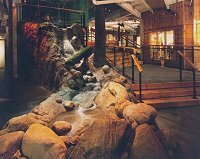 Canada is a land of lakes, rivers and the world's longest coastline. The materials needed to build canoes - bark, skin and cedar - flourish naturally in the northern half of North America. This exhibit explores the canoe's relationship to the environment, featuring a dramatic waterfall, and an enormous 15' x 20' map showing Canada's extensive network of waterways. Visitors ascend a series of platforms and stairs as they begin their journey through the Canadian Canoe Museum. Canada is a land of lakes, rivers and the world's longest coastline. The materials needed to build canoes - bark, skin and cedar - flourish naturally in the northern half of North America. This exhibit explores the canoe's relationship to the environment, featuring a dramatic waterfall, and an enormous 15' x 20' map showing Canada's extensive network of waterways. Visitors ascend a series of platforms and stairs as they begin their journey through the Canadian Canoe Museum.
Origins Gallery
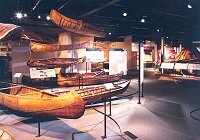 This exhibit pays tribute to the continuing technological and cultural innovations of Aboriginal people in developing the canoe. Several First Nations cultures are profiled here, such as the Nuu-chah-nulth and their huge whaling dugouts, the exquisite birch bark canoes of the Algonquin, the sleek kayaks of Eastern Arctic Inuit, and the ocean-going birch bark canoes of the Mi'kmaq and Maliseet. Canoes and/or kayaks were integral to most Aboriginal cultures, used for trade, transportation, hunting/fishing, warfare, gifts and ceremonies. This exhibit pays tribute to the continuing technological and cultural innovations of Aboriginal people in developing the canoe. Several First Nations cultures are profiled here, such as the Nuu-chah-nulth and their huge whaling dugouts, the exquisite birch bark canoes of the Algonquin, the sleek kayaks of Eastern Arctic Inuit, and the ocean-going birch bark canoes of the Mi'kmaq and Maliseet. Canoes and/or kayaks were integral to most Aboriginal cultures, used for trade, transportation, hunting/fishing, warfare, gifts and ceremonies.
Trade & Alliance
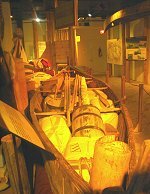 Aboriginal trading networks covered all of North America, and were responsible for moving materials such as obsidian, shells, iron, copper and silver thousands of miles, usually by canoe. When Europeans arrived, they benefited from this extensive commercial tradition, and used it to gain access to other materials, primarily furs. As European demand for furs increased, the canoes needed to transport them grew significantly, reaching more than 30 feet in length. The Fur Trade period lasted 300 years, and here visitors will learn about the Hudson's Bay Company and the Northwest Company, the lives of voyageurs and the Métis Nation, as they explore a recreated shoreline encampment and peer inside a fully loaded 26-foot canot du nord. Aboriginal trading networks covered all of North America, and were responsible for moving materials such as obsidian, shells, iron, copper and silver thousands of miles, usually by canoe. When Europeans arrived, they benefited from this extensive commercial tradition, and used it to gain access to other materials, primarily furs. As European demand for furs increased, the canoes needed to transport them grew significantly, reaching more than 30 feet in length. The Fur Trade period lasted 300 years, and here visitors will learn about the Hudson's Bay Company and the Northwest Company, the lives of voyageurs and the Métis Nation, as they explore a recreated shoreline encampment and peer inside a fully loaded 26-foot canot du nord.
Preserving Skills Gallery
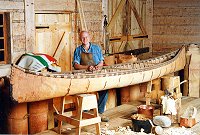 Here, ongoing demonstrations will introduce visitors to how canoes are built using rolls of birch bark, spruce root, and cedar planking. Situated inside a replica 18th French Canadian canoe building shed, this "living exhibit" will be the venue for the Museum's Visiting Artisans Program, where heritage skills from across Canada are kept alive through hands-on activities. Here, ongoing demonstrations will introduce visitors to how canoes are built using rolls of birch bark, spruce root, and cedar planking. Situated inside a replica 18th French Canadian canoe building shed, this "living exhibit" will be the venue for the Museum's Visiting Artisans Program, where heritage skills from across Canada are kept alive through hands-on activities.
The Land Becomes Canada
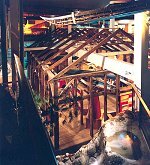 During the 19th century, canoes were invaluable in extending the reach of the railroad, and they were used heavily during gold rushes and expeditions by the Geological Survey of Canada. In this exhibit, visitors enter an original 1876 Hudson's Bay Company trading post as they learn about provisioning canoeing journeys into Canada's northwest. Visitors also meet some of the early adventurers who paddled through some of the most remote areas of the country. During the 19th century, canoes were invaluable in extending the reach of the railroad, and they were used heavily during gold rushes and expeditions by the Geological Survey of Canada. In this exhibit, visitors enter an original 1876 Hudson's Bay Company trading post as they learn about provisioning canoeing journeys into Canada's northwest. Visitors also meet some of the early adventurers who paddled through some of the most remote areas of the country.
It Wasn't All Work
 As new modes of transportation became more practical for moving people and products around the country, paddling became a favourite recreational pastime. As new modes of transportation became more practical for moving people and products around the country, paddling became a favourite recreational pastime.
During the Victorian era, canoes were popular for regattas, races, and courting, reflecting the many lifestyle changes happening in Canadian society at the time. The era of cottaging, and escaping from the growing cities is profiled for visitors from a dock setting.
Summer Strokes
 For many Canadians, canoeing was first experienced during their summer vacations, often at youth camps. Our trip shed conjures the nostalgia associated with this time. Here visitors can also step off the dock into a real canoe -- without getting wet. Discover Canada's best canoe routes through its many famous parks and wilderness areas, and even test your ability to outfit properly for a paddling trip. For many Canadians, canoeing was first experienced during their summer vacations, often at youth camps. Our trip shed conjures the nostalgia associated with this time. Here visitors can also step off the dock into a real canoe -- without getting wet. Discover Canada's best canoe routes through its many famous parks and wilderness areas, and even test your ability to outfit properly for a paddling trip.
The Peterborough Tradition
 The wooden-plank canoe was invented in central Ontario, spawning a huge manufacturing industry that distinguished Peterborough as the "canoe capital of the world". The wooden-plank canoe was invented in central Ontario, spawning a huge manufacturing industry that distinguished Peterborough as the "canoe capital of the world".
Many of these early canoes are still paddled today, and the incredible wood-working techniques are demonstrated in the Museum's boat-building workshop.
Reflections: The Land, The People and The Canoe

Pierre Elliott Trudeau's birch bark canoe and Bill Mason's red Prospector canoe
|
Symbol of the people, heritage, and natural beauty of Canada, this exhibit explores some of the ethereal aspects of the canoe.
Profiling legendary paddler Bill Mason, Algonquin elder William Commanda, Pierre Elliott Trudeau and many others, this evocative display captures for visitors the enduring spiritual significance of the canoe to the peoples of Canada.
|















